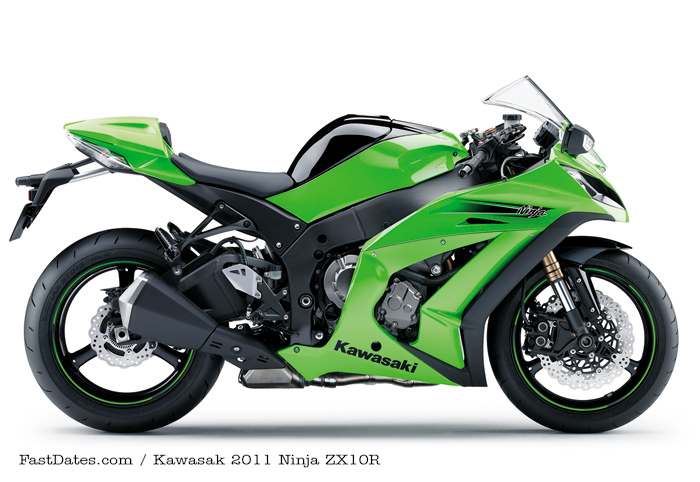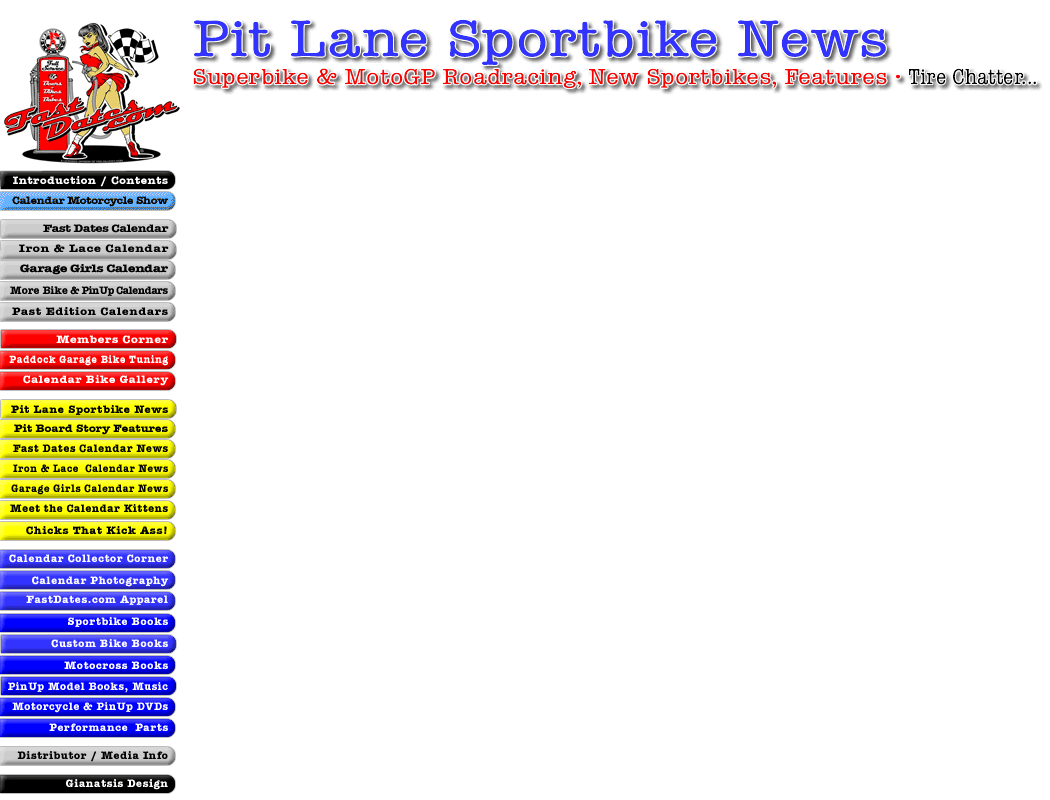|  The all new 2011 200hp Kawasaki ZX10R The all new 2011 200hp Kawasaki ZX10R
Intermot, Germany, October 5th, 2010 - Featuring a new engine, new frame and new suspension, Kawasaki’s newest litrebike flagship represents the first complete redesign since the Ninja ZX-10R’s debut in 2004, and offers a significant jump in base performance. Ninja ZX-10R models have always pursued the highest circuit performance. To remain competitive, each successive model has offered more power and more control. The latest
machine is no exception. Featuring a new engine, new frame and new suspension, Kawasaki’s newest litrebike flagship represents the first complete redesign since the Ninja ZX-10R’s debut, and offers a significant jump in base performance.
Designed to enable a greater number of riders to experience the thrill of riding a superbike at the limit, the new Ninja ZX-10R is loaded with cutting-edge technology. New features like Kawasaki’s new race-type traction control system (S-KTRC) and supersport-grade ABS (KIBS) are there to assist riders explore the limit. From stock Titanium race headers, traction contol and anti-lock brakes, a slipper clutch, to even an Ohlins steering damper, this is the highest spec Superbike to appear on the scene. The new engine produces 200.1 hp on a static dyno without the advantage of it's ram air, making this the most powerful production litre bike in the world, the perfect weapon for Paul Bird Team Kawasaki to base its assault with a vengence on the 2011 World Superbike Championship.


All New Engine
Designed for both stunning maximum power and manageability, the all-new engine offers a 147.1 kW (200.1 PS) output (without Ram Air), increased throttle control and an engine character that enables more time at full throttle. The new engine offers linear power delivery right to its heady peak power. Great care was taken to ensure ideal engine manageability during all parts of the corner: getting off the throttle in corner entry, getting back on the throttle mid-corner, opening the throttle on corner exit. Peak torque was moved to the higher rpm range, eliminating the torque peaks and valleys that made it difficult for racers to open the throttle with confidence. Keeping mid-range torque at a level no more than necessary further facilitates getting back on the gas.
The new engine features a completely revised crank/transmission shaft layout: the transmission input shaft is now located above the other two. Further, relative to the output shaft, the crankshaft is now located about 10 degrees higher. The new layout contributes to a higher centre of gravity and more centralised mass, enabling even more nimble handling.
• Cylinder bores are machined with a “dummy” head bolted in place, yielding improved bore circularity and cylindricity. As a result of the increased precision, lower tension piston rings can be used, reducing mechanical loss.
• The new engine also features offset cylinder shafts: relative to the crankshaft, the cylinder bore centres are positioned 2 mm toward the exhaust side of the engine. This results in reduced lateral piston force at the point of maximum combustion pressure (reducing mechanical loss) and lower piston loads (enabling the use of lighter pistons).
• Larger intake valves (30 mm >> 31mm) and wider intake ports are complemented by 24.5 mm exhaust valves and completely revised exhaust ports. The new arrangement contributes to more efficient breathing, reduced engine braking effect, more linear power delivery and increased control on throttle opening.
• High-lift cams offer increased valve lift and revised valve overlap.
IN: 9.7 mm >> 10.3 mm EX: 8.5 mm >> 9.1 mm
• This also contributes to the idealised engine braking, offering improved rear wheel traction, as well as greater stability and increased control on corner entry. The changes also facilitate carrying speed into corners (also due to revisions to the chassis), and, along with the engine’s overall character, increase the ability to control the chassis using the throttle.
• Larger-diameter intake tappets (26.5 mm >> 29 mm) are used to suit the high-lift cams.
• New lightweight pistons features shorter skirts (20 mm >> 16.5 mm). Using thinner oil rings (1.5 mm >> 1.2 mm) accommodates the deeper recesses necessary to suit the higher-lift cams.
• Camshafts made of chromoly (formerly cast iron) contribute to weight savings. The camshafts receive a revised soft nitriding treatment and the cam portions receive a lapping treatment to ensure sufficient durability to handle the heavier valve springs needed for use with high-power cams and increased operating speed.
• Connecting rods feature stronger rods and big ends to suit the increased power output.
• The crankshaft is made from harder material features stronger pins and journal fillets. Durability of the gear teeth was also increased.
• New ignition stick coils have greater secondary coil current. The improvedcombustion efficiency results in improved performance and driveability.
• A single-shaft secondary balancer helps reduce engine vibration. Its use allows a number of vibration-damping parts to be simplified, contributing to weight savings. (In particular, handlebar weights could reduced, improving steering response.)
Cassette Race Style Transmission
Race-style cassette transmission facilitates gear ratio changes to suit track conditions. With the revised engine layout, the “cassette” is located high enough hat it can be accessed without having the engine oil drain out.
Fine-tuned primary and final reduction ratios minimise rear end movement (squat/lift) on acceleration/deceleration. The more composed rear enables greater freedom with suspension settings. Closer 4th, 5th and 6th gear ratios complement the Ninja ZX-10R’s circuit performance.
Primary reduction ratio: 1.611 (87/54) >> 1.681 (79/47). Final reduction ratio: 2.412 (41/17) >> 2.294 (39/17).
Ram Air / Airflow / Dual injection
Ram Air intake is positioned closer to front of the bike (where air pressure is higher), contributing to increasedairbox filling efficiency. New airbox has a higher ceiling, allowing air to enter the intake funnels from above, for more efficient breathing. Airbox volume has also increased (8 litres >> 9 litres) and a new air filter offers a greater effective area (up approximately 48%), both of which further contribute to efficient breathing.
Oval intake funnels (velocity stacks) contribute to flow efficiency. Throttle bodies features larger ø47 mm main throttle valves (previously ø43 mm) for increased power and improved throttle control. Oval sub-throttle valves are also correspondingly larger. An ISC (Idle Speed Control) valve mounted on the throttle body unit automatically adjusts idle speed for more stable performance. In addition to helping meet emissions requirements, this device contributes to easier starting and improved driveability from stops.
Exhaust System
New exhaust header pipes, formed from heat-resistant titanium alloy, have almost the same length and diameter as their race-use
counterparts. (This feature makes it easier for riders to increase exhaust performance (for track applications) without having to replace the entire exhaust system.) Header collectors (4-2 and 2-1 sections) are hydroformed, resulting in a simple, lightweight construction. A larger-volume pre-chamber (formed from stainless steel) contains two catalysers and an exhaust device located at the pre-chamber exit. The pre-chamber enables both reduced exhaust noise and high performance, and contributes greatly to mass centralisation.

New Frame
The chassis, featuring an all-new aluminium twin-spar frame, was completely re-evaluated for enhanced handling, high controllability and significant weight savings. The new twin-spar frame traces a more direct line from the head pipe to the swingarm pivot. This delivers more linear behaviour, translating to greater control. Frame twist was designed to be as close to the main pipes as possible, which further facilitates rider control.
Frame also offers increases cornering stability and a high level of feedback. The new frame is an all-cast construction consisting of only seven pieces. This afforded engineers a great deal of design freedom. Wall thickness could be minimised while ensuring the required strength and rigidity. Fewer pieces also means fewer welds, contributing to a higher-quality appearance and reduced variance in production. Engine hangers (for the upper engine mounts) are unitised with the frame’s mainpipes, contributing to weight savings.
Aluminium swingarm
Like the frame, the swingarm is an all-cast (3-piece) construction. The swingarm’s rigidity balance was designed to complement the frame.

Horizontal Back-Link Rear Suspension
New rear suspension positions the shock unit and linkage above theswingarm. The new arrangement offers a number of benefits, including increased road holding (especially in the final third of the stroke range), smoother suspension action from initial through mid-stroke (even with hard settings), increased stability and feedback when cornering, as well as contributing to mass centralisation.The Horizontal Back-link rear suspension arrangement frees up space taken up by the Uni-Trak suspension lower linkage, enabling a larger pre-chamber, which in turn allows the use of a shorter muffler and contributes to mass centralisation.
 Cutting-Edge Traction Control to Help the Rider Explore the Edge Cutting-Edge Traction Control to Help the Rider Explore the Edge
A number of new high-tech features facilitate rider control and assist riders experience the thrill of riding a high-powered superbike at the limit. S-KTRC (Sport-Kawasaki TRaction Control), Kawasaki’s predictive race-type traction control, helps riders push harder on the racetrack by maximising acceleration. KIBS (Kawasaki Intelligent anti-lock Brake System), Kawasaki’s supersport-grade high-precision ABS, uses high-precision control to offer added braking reassurance in emergency situations while minimising intrusion during hard sport riding. Power Mode selection offers riders a choice of power delivery to suit conditions.
Predictive race-type traction control: S-KTRC (Sport-Kawasaki TRaction Control)
Highly sophisticated system is based on MotoGP racing technology. Unlike the KTRC system used on the 1400GTR ABS (Concours 14 ABS in
N. America), which was designed to offer rider reassurance when traversing slippery surfaces, S-KTRC, which was designed to maximise
forward motion, allows riding at the edge of traction.
The quickest acceleration requires a certain amount of slip, so, in order to optimise traction, S-KTRC actually allows slip. The ideal slip ratio varies according to conditions. The system looks at a number of parameters to get an accurate real-time picture of what is going on: front and rear wheel speed (slippage), Δ engine rpm, Δ throttle position, Δ slippage, Δ acceleration, etc. Using complex analysis, the system is able to predict when traction conditions are about to become unfavourable. By acting before slippage exceeds the range for optimal traction, drops in power can be minimised, resulting in ultra-smooth operation. The system is also able to distinguish between torque wheelies, which are smooth, and sudden wheelies, which can be dangerous. Torque wheelies are allowed as long as acceptable acceleration is maintained. Sudden wheelies trigger system intervention.

New Suspension BPF (Big Piston Front Fork)
The new BPF with ø43 mm inner tubes is one of the great contributing factors to the new Ninja ZX-10R’s enhanced composure under braking. Compared to a cartridge-type fork of the same size, the BPF features a main piston almost twice the size (ø39.6 mm vs ø20 mm on ZX1000F); oil inside the BPF acts on a surface area almost four times the size. The larger surface area allows the damping pressure to be reduced while ensuring the damping force remains the same. Reducing the damping pressure allows the slide pipe to move more smoothly, which is especially noticeable at the initial part of the stroke. The result is greater control as the fork begins to compress and very calm attitude change as vehicle weight shifts forward when reducing speed, and thus greater chassis stability on corner entry.
Because the BPF eliminates many of the internal components used in a cartridge-type fork, construction is simplified resulting in lighter overall fork weight.

Complete Factory ZX109-11 Specification Sheet PDF
Return
to Kawasaki
Index • New
Bike Index • Pit
Lane News
|
